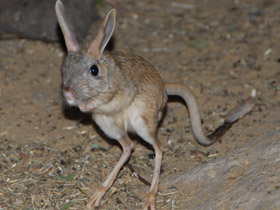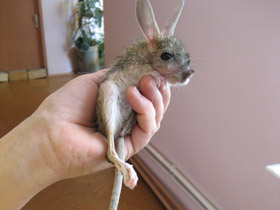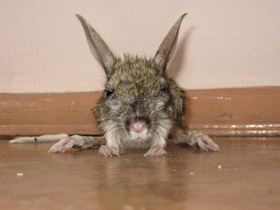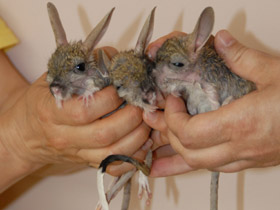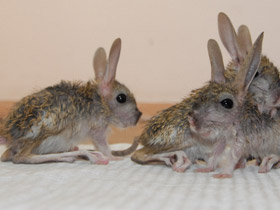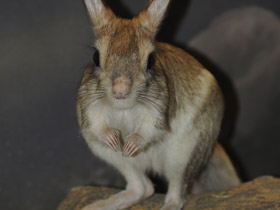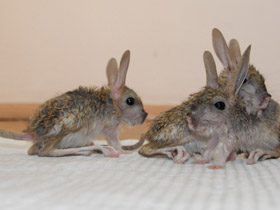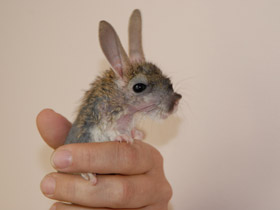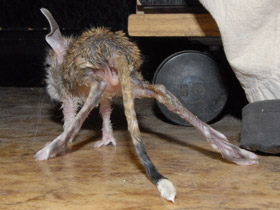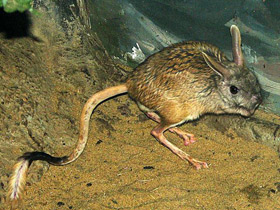The great jerboa (Allactaga major)
The great jerboa (Allactaga major) is a species of rodent in the family Dipodidae.
Species range, distinctive features
Allactaga major is the largest representative of the family. It has a relatively short body with length from 19 to 26 cm; tail is 1.3 times longer than the body and reaches a length of 25-30.5 cm; body weight is more than 300 g. The head of Allactaga major is relatively short and wide, the snout is slightly elongated, but the snout is broad. The head of the Allactaga major is relatively short and broad, the snout is slightly elongated but broad, ending in a nickel. The ears of this animal are relatively short, 57-59 mm high, but the feet are unusually long, reaching 45% of the body length. The upper body colouration of the gopher tortoise is from brownish-grey to pale sandy-grey with reddish tones of different intensity. This rodent is distributed from forest-steppes to semi-deserts and the northern part of the desert zone in Eastern Europe, Kazakhstan and in the south of Western Siberia. To the north it penetrates further than other species of marmosets, going beyond 55° north latitude. The range of the species is represented by a continuous massif and one isolate, which is located to the south and south-west of Lake Balkhash in the northern foothills of the Tien Shan; its area is about 82,400 km2. The main range extends from the Black Sea to the Ob River and the Altai Mountains. Its southern border runs along the northern coast of the Black Sea, the foothills of the Caucasus, skirts the Caspian Sea from the north, crosses the Mangyshlak Peninsula and goes eastwards, skirting the Aral Sea from the north, Lake Balkhash and further to the Zaisan Basin. Allactaga major inhabits desert steppes, semi-deserts and deserts, except sandy ones. In areas with dense soil and sparse vegetation it is widespread in the steppe zone (especially west of the Volga), penetrates into the forest-steppe and even the southern part of the taiga zone (in Western Siberia). Here it settles on the slopes of river valley gullies, roadsides, in meadows and glades. In the mountains this rodent rises up to 1600 m above sea level (in northern Kyrgyzstan).
Habitat, lifestyle and habits
Allactaga major is active during twilight and night time. Most of the animals come to the surface 30-40 minutes after sunset and go into burrows, depending on the season and latitude of the area, 0.3-1.5 hours before sunrise. Allactaga major is notable for its considerable speed and manoeuvrability of two-legged running: chased by a car, it can reach speeds of up to 40 km/h. This rodent lives in solitary, independently dug burrows, among which there are more complex permanent (summer and hibernation) and simpler temporary (summer) burrows. The former (especially winter burrows) are characterised by considerable depth, a flat, elongated earthen outlet located at some distance from the entrance hole, and the presence of one or more chambers and snouts. The entrance hole of permanent dens is shaped like a vertically elongated oval and is most often blocked with an earthen plug. Temporary dens are shallow, in the form of an open, oblique passage going underground, with or without a chamber at the end; they can be rebuilt by the animals into permanent dens in the same way as summer dens are rebuilt into winter dens. In the north of the distribution area large gopher tortoises often occupy abandoned burrows of gophers.
What Allactaga major feeds on
In spring Allactaga major feeds mainly on underground parts of plants and their young shoots, however, with the beginning of ripening their main food is seeds. Allactaga major also eats a variety of insects. It easily switches from one type of food to another depending on its availability and the time of year. On agricultural lands Allactaga major often collects sown seeds of watermelons and melons, feeds also on grains of cultivated cereals, sunflower seeds, peas, but causes insignificant damage.
Winter hibernation of Allactaga major
The Greater Ruff emerges from hibernation in mid-March-April. The species is characterised by one long breeding period, which peaks in April-June. There are 1-2 broods per year; pregnancy lasts about 25 days. The brood consists of 1 to 8, usually 3-6 cubs. They live with the female for up to 1.5 months and reach sexual maturity in the 2nd year of life. The maximum life expectancy of tushkans in the wild is up to 3 years.
In autumn, with the onset of permanent frosts, gnats go into hibernation. Usually it happens in September, less often in October. Duration of hibernation in different regions varies from 4 to 6.5 months; during thaws it can be interrupted. Large gerbils do not store food; before hibernation they become very fat, sometimes doubling their body weight.
Status
The great jerboa has a very wide range and over much of that range is common in suitable habitat. However it is threatened in Ukraine and European Russia by intensification of agriculture and other alterations to its habitat. It has become extinct in the Moscow district where dachas have been built and other man-made alterations have occurred to the landscape. The International Union for Conservation of Nature have listed it as being of "least concern" but thinks populations should continue to be monitored.

















